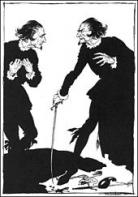Horace Walpole (September 1717- March 1798) first applied the term “Gothic” to his 1764 novel The Castle of Otranto. When he set out to write his novel he intended to combine elements of the medieval and the modern style. Set in a haunted castle, the novel follows the story of a Prince who develops a passionate infatuation with the young woman that is betrothed to his son. After the rather ominous death of his son, the Prince spends the rest of the narratives trying to avoid further destruction. This novel introduced some of the tropes that became integral to the conventions of Gothic fiction such as impending curses, mysterious rooms, and the direct or indirect involvement of the supernatural.
The Second Self and The Gothic Novel
Created by Deanna Whitlow on Thu, 12/09/2021 - 14:14
The conventions of the Gothic novel give way to an exploration of duality and double consciousness. We can see this in both The Picture of Dorian Gray and in Robert Louis Stevenson's Strange Case of Dr. Jekyll and Mr. Hyde.
Timeline
Chronological table
|
Date |
Event | Created by | Associated Places | |
|---|---|---|---|---|
| 1764 |
The Castle of Otranto by Horace WalpoleHorace Walpole (September 1717- March 1798) first applied the term “Gothic” to his 1764 novel The Castle of Otranto. When he set out to write his novel he intended to combine elements of the medieval and the modern style. Set in a haunted castle, the novel follows the story of a Prince who develops a passionate infatuation with the young woman that is betrothed to his son. After the rather ominous death of his son, the Prince spends the rest of the narratives trying to avoid further destruction. This novel introduced some of the tropes that became integral to the conventions of Gothic fiction such as impending curses, mysterious rooms, and the direct or indirect involvement of the supernatural. |
Deanna Whitlow | ||
| Oct 1839 |
“William Wilson” by Edgar Allan PoeThe short story “William Wilson” by Edgar Allan Poe (January 1809- October 1849) was first published in Burton’s Gentleman’s Magazine in October of 1839. The story follows the titular William Wilson, a man of noble descent, through adolescence to adulthood. In primary school, he meets another boy who looks and dresses exactly like him but can only speak in a whisper. William’s doppelganger tries to offer him advice, but he does not listen. In fear, William leaves the academy that they both attended. As a young man, William is haunted by his double as he commits acts of mischief and debauchery. His double is always there, thwarting the selfish and dangerous plans that William has. One day, William finally confronts his double and ends up killing him after a sword fight. However, after stabbing his double, a mirror appears, revealing to William that he had subsequently killed himself. This story serves as one of the major introductions of the doppelganger in Gothic Literature. |
Deanna Whitlow | ||
| 5 Jan 1886 |
Strange Case of Dr. Jekyll and Mr. Hyde by Robert Louis StevensonStrange Case of Dr. Jekyll and Mr. Hyde by Robert Louis Stevenson (November 1850- December 1894) is one of the most popular stories of “the second self”. Told mainly from the perspective of lawyer Mr. Utterson, the story follows him as he works to solve the mystery of his friend Dr. Jekyll as well as the murder of one of his clients by a man called Mr. Hyde. While watching the decline of Dr. Jekyll, Mr. Utterson slowly begins to put the pieces together, and all is resolved by a direct confession by the doctor. He tells of how he created a drug that would allow him to split himself into two: Dr. Jekyll as the good version and Mr. Hyde as the evil version. After running out of one of the ingredients of the drug, Dr. Jekyll realized that he would be permanently transformed as Mr. Hyde. After writing his account of events, he locked himself in his laboratory and poisoned himself. The novel was very well received and has been widely adapted. |
Deanna Whitlow |



